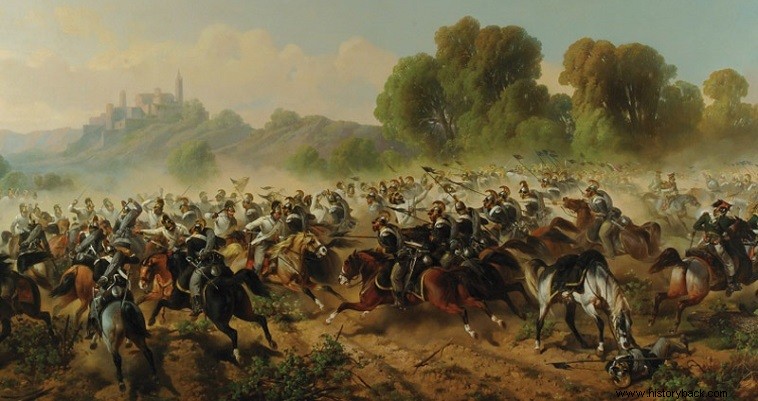
1848 was a turbulent year for all of Europe. Movements broke out in France, Hungary, Italy, and elsewhere. In Hungary a portion of the population rose up against the Austrian overlords. The same thing happened in the Austrian-occupied Italian territories.
In Italy, however, the revolutionary movements were supported by the independent Italian kingdom of Piedmont - Sardinia, which aspired to unite the Italian peninsula under the crown of the House of Savoy.
In March 1848 the inhabitants of Milan rose up and asked for the reinforcement of the Italian king Carlo Albertus. The latter not only promised help but declared war on the Austrians taking advantage of their involvement in Hungary and mobilized his army.
Opposite him, the Austrian marshal Radetzky , the mastermind behind the plan that led to Napoleon's defeat at Leipzig, having smaller forces at his disposal, decided to act cautiously, initially taking a defensive stance. The Austrian forces were concentrated in the fortified cities of Verona, Mantua, Pesciera and Legnano.
The Italians, however, moved quickly and occupied Pesierra. In the meantime, Radetsky was reinforced and decided to counter-attack by maneuvering on internal lines.
The Austrian marshal took advantage of the fact that Italian forces were overextended throughout the region and with 33,000 men attacked the Italian II Army Corps (SS) of General Ettore de Sonnage on July 23.
After this Radetzky crossed the river Minzio and "cut" the Italian forces in two intending to act on internal lines, successively hitting the Italian forces on either side. The Italians reacted and tried to hit the rear of the Austrian army at Stafalo. The one Austrian brigade stationed there could not withstand the pressure of the entire Italian I SS and was forced to retreat.
Radetzky reacted immediately and turned the bulk of the Italian forces. The Italians did not expect such a reaction and their leadership ordered an attack against the Austrians with two SS. Due to poor coordination, however, only one was in front of the opponents.
But instead of being the aggressors, the Italians soon unexpectedly found themselves facing two enemy SS and instead of a glorious advance they found themselves fighting a battle for survival at Custoza on July 25.
Thus, although the Italian army was numerically superior, in the field of Custoza it found itself with 22,000 men, compared to more than 30,000 of Radetzky. The battle continued until the afternoon when finally Italian morale collapsed and the signal for retreat was given, despite the fact that they had less casualties than their opponents.
The Italians had losses of around 2,500 dead, wounded and prisoners, in the three days of July 23-26, compared to twice the Austrians. However, the Italians had completely lost their morale, from their king, who accompanied the army, to the last cook.
It was then proposed that the essentially intact Italian army move towards Milan in aid of the revolutionaries. But after a small skirmish near the city, the Italians asked for a truce.
It is worth noting, however, that the following year the Italians violated the truce and attempted a new attack. But at Novara, although they had 75,000 men against 47,500 Austrians, they were defeated again. Only then did they admit defeat.
